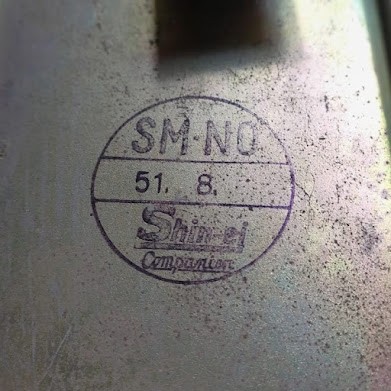☟
If you've ever owned one of the endless amounts of Shin-ei built pedals, then you've probably seen a cryptic circular stamp with odd letters and numbers somewhere on the bottom plate. They tend to come in varying sizes and somewhat different layouts. And if you don't know what you're looking at, it can be very tempting to just disregard this stamp altogether. But it's precisely this confusion that has lead pedal enthusiasts to incorrectly date these legendary stompboxes for at least two decades now...
So today I think it would be helpful to go through the history of Shin-ei date stamps, and how to decipher what they actually mean...
To start off we need to understand why these numbers are not formatted using the typical Gregorian calendar. And the best way to think about it, is that in Japan the date is based on the reign of the current emperor
(*to really just reduce it down for the sake of this article...).
So from 1926-1989 this was the period of Emperor Shōwa. Which would mean that 1926 is year 1, and then you simply count up from there.
But don't worry, I got you! I made this little chart with a date range you could possibly find on vintage Japanese pedals:
Now in addition to simply knowing how to read these numbers, Shin-ei also used different stamps at different periods. And I have taken a stupid amount of time to go through literally hundreds of photos and figure out which stamp style came out when.
So let's get into it!
The earliest stamp I have found (so far) is from March of 1970. Which makes sense because the end of 1969 saw Shin-ei go through a huge change and expansion. Honey had just gone out of business, Univox seemed to cancel a large portion of their contract, and "Companion", Shin-ei's house brand, was just getting going. And even though they had been manufacturing pedals since 1967, I believe it wasn't until early 1970 when they started using date stamps.
These early stamps were much smaller, and simply had the "SM" "NO" labeling with the Shōwa year and month codes (sometimes in both English and Japanese):
This format was used for nearly two years, until January of 1972 when we would see our first big stamp.
*as of now I have yet to find a small stamp dated after December 1971 (46.12), or a large stamp dated before January 1972.
This new stamp did away with the Shōwa formatting, and instead used a Gregorian dating style. I can only assume this decision was made because of the large amount of US brands that had contracts with Shin-ei?
This new format combined the "SM" and "NO" into a single line, and added the Companion logo. The below example can be read as "January of 1973":
This new style though, lasted only a single year. And by March of 1973 the date stamp we are most familiar with came into existence.
It was the same size and followed roughly the same format, with two major exceptions; they went back to the Shōwa dating, and altered the logo to say "Shin-ei, Companion".
This change came about as the company was going through yet another rebranding period. And in January of 1973 we would see the first "Shin-ei, Companion" labeled effects. *interestingly, for two months there was a small cross-over of the previous "Companion" stamps on products with the new "Shin-ei, Companion" labeling.
This stamp style stayed with Shin-ei until the very end, lasting around 5 years in total. It is by far the most common version you will come across.
One thing to note is that from 1973 to 1975 there seems to be no "Companion" labeled products. But for some reason Shin-ei decided to bring it back, and for a while was simultaneously making effects under both brandings.
Finally, and I wouldn't be doing my job if I didn't mention this, but as of now I have only found one stamp like what you see below. It appears to be from May 31st of 1976!? But I have not encountered any other stamps like this, with exact days on them (yet). I have seen stamps just before this, and the one above which is only 3 months later, and neither include the exact date... So maybe this was a funky thing they were trying out for a minute, or maybe it was for a specific brand or style? (this is on a Shin-ei labed FY-6, for reference). So who knows? But yeah, this is the only other variation I have come across. *please excuse the blurriness
I know some of you are probably reading this and (hopefully) are excited that you can now accurately date your pedals.
But I also know that more of you are being hit with the realization that your "1968 Shin-ei FY-6" was actually made in 1974...
And that's ok! It doesn't make it any less cool. I promise. The shroud of mystery that looms over Shin-ei is still very dark, and there's literal tons of information we do not yet know (like who actually invented the Super Fuzz?). But as we dig deeper and deeper, and utilize our collective wisdom, we can continue to inch closer to the truth.
So that all being said, I am trying to catalog as many Shin-ei pedals as possible in order to figure out an even more accurate timeline, and to help uncover the still many mysteries with this brand. If you feel compelled, please reach out via Email or Instagram and tell me about your Shin-ei pedal! I'm most interested in the Super Fuzz and FY-2 timelines, but literally any info related to Shin-ei, Honey, Univox will help get us all closer to the true history of this iconic brand.
thanks for reading!
-ed














